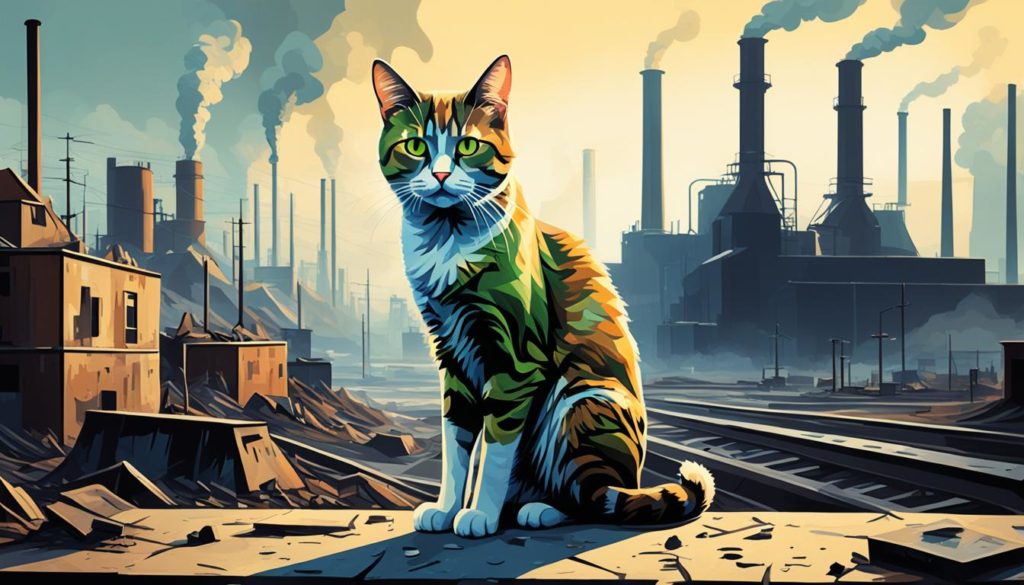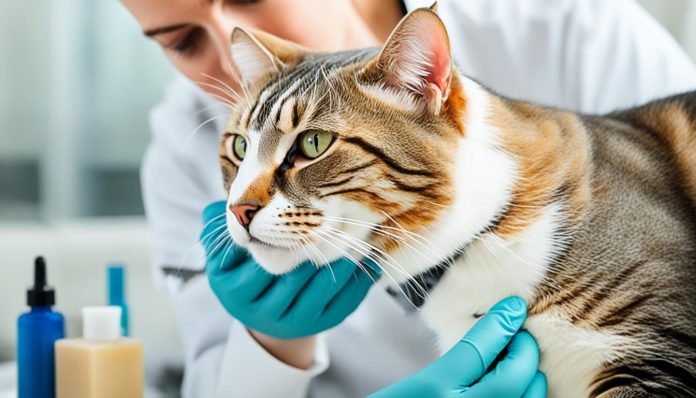Did you know feline acne affects up to 25% of cats? This common skin issue appears as blackheads, pimples, and red skin around the chin and lips. It can make cats uncomfortable and may lead to worse skin infections if ignored.
Many pet owners don’t fully grasp cat skin issues, including feline acne. Its causes vary from diet to environment. Knowing why it happens, spotting symptoms early, and choosing the right treatment are key. This ensures your cat stays happy and healthy.
Key Takeaways
- Up to 25% of cats may experience feline acne.
- Symptoms include blackheads, pimples, and inflamed skin around the chin and lips.
- Feline acne can result in severe skin infections if left untreated.
- Understanding and addressing the causes is essential for effective treatment.
- Early identification and timely veterinary care are crucial.
What is Feline Acne?
Feline acne is a skin problem in cats, mainly on the chin and lip area. It happens when hair follicles get clogged with too much sebum and keratin. Knowing the causes of feline acne is key for treating it right.

Definition and Overview
Feline acne happens when the hair follicles on a cat’s chin and lips get blocked. This is often because there’s too much sebum and keratin. These clogs turn into blackheads, causing inflammation and discomfort.
Common Symptoms
Look out for blackheads, redness, swelling, and sores as common signs of feline acne. Sometimes, infections can follow, making things worse. Spotting these signs early is important for quick and effective treatment.
Causes of Feline Acne
Feline acne comes from many places. It’s key to know these causes for your cat’s skin care. Let’s look at the main reasons why cats get acne.
Environmental Factors
How a cat lives affects its skin health. Dirty bowls and dirty places can lead to more acne. Keeping your cat’s areas clean is very important.

Dietary Influences
What your cat eats matters a lot too. Allergies to food can make acne worse. So, watch what your cat eats and try special diets if needed.
Hormonal Changes
Hormones can also cause acne in cats. This is common in young and middle-aged cats. It’s good to talk to a vet about these hormone changes.
Identifying Feline Acne in Your Cat
It’s crucial to spot feline acne early to prevent it from getting worse. We’ll look at what to watch for and behavior changes. These can signal your cat is having acne issues.
Visual Signs
Look for blackheads, pustules, and red skin on your cat. You’ll mostly see these around their chin and lips. If you spot small black dots or big pus bumps, your cat needs acne treatment.
Behavioral Changes
Acne might make your cat act differently. They may scratch more, rub their chin, or show pain when touched. These are signs that your cat may need help with acne. Spotting these early helps keep your cat happy and healthy.
Common Feline Dermatology Issues Linked to Acne
When we talk about feline acne, it’s important to know it’s linked to other cat skin problems. Issues like dermatitis and infections from bacteria or fungi can look similar. This makes it really important to get the right diagnosis.
Associated Skin Conditions
Problems such as dermatitis can have the same signs as feline acne. Signs include redness, swelling, and sometimes sores. Bacterial infections can look similar too.
Ringworm, which is a fungus, can cause round, bald spots and flaky skin. These signs might be confused with acne.
Allergies and Irritations
Allergies can affect a cat’s skin and make acne symptoms worse. Cats can be allergic to food, pollen, or flea bites. Finding these allergens is key to help reduce skin problems and help with acne treatment.
Working with a vet dermatologist is important. They can help find out what’s causing the issue and treat it effectively. This helps make your cat comfortable and tackles the problem right at its root.
Treating Cat Acne: Effective Methods
To treat cat acne, use a mix of topical treatments, meds, and home practices. Each method has a special role. They ease symptoms now and stop more from happening later.
Topical Treatments
Using topical treatments is key for cat acne. Benzoyl peroxide gel, medicated shampoos, and antibiotic ointments help a lot. They fight inflammation and bacteria. Make sure to apply them right for the best effect.
Medications
Some cats need stronger medicines. Vets might give them antibiotics or steroids. These fight infections and swelling. It’s important to use them as the vet says to avoid bad reactions.
Home Remedies
Home remedies also help prevent cat acne. Cleaning the cat’s chin gently and using special dishes are good ideas. They cut down on germs and stop acne from coming back.
| Treatment Method | Products | Purpose |
|---|---|---|
| Topical Treatments | Benzoyl Peroxide Gel, Medicated Shampoos, Antibiotic Ointments | Reduce Inflammation, Combat Bacteria |
| Medications | Antibiotics, Steroids | Treat Severe Cases, Reduce Inflammation |
| Home Remedies | Hypoallergenic Wipes, Stainless Steel/Ceramic Dishes | Prevent Future Outbreaks, Minimize Irritants |
Natural Remedies for Managing Feline Acne
Feline acne treatments often use natural ways to heal. They avoid the harsh effects found in synthetic products. Pet owners prefer herbal treatments, supplements, and skincare to manage this usual skin issue.
Herbal Treatments
For feline acne, aloe vera and witch hazel are top choices. They have antiseptic and anti-inflammatory powers. These help fight infection and reduce swelling in acne areas.
Dietary Supplements
Adding omega-3 supplements can make your cat’s skin healthier. These fats fight inflammation and help their coat look great. They are key for fighting feline acne.
Preventive Skincare Practices
To control feline acne, prevention is crucial. Clean your cat’s sleeping area and toys often. Keeping their surroundings tidy boosts the effect of natural treatments.
Feline Acne Prevention Tips
Stopping feline acne means regular cleaning, the right diet, and managing stress. Cleaning your cat’s skin well keeps current and future skin problems at bay.
Regular Cleaning Practices
Keeping your cat acne-free involves clean habits. Wipe your cat’s chin and face often, especially after eating. Use pet-safe wipes or a damp cloth for this.
Also, clean their bowls every day to stop bacteria growth. This keeps skin healthy.
Proper Diet and Nutrition
A diet full of essential fatty acids is key for healthy skin and fur. Foods with Omega-3 and Omega-6 can prevent acne. Talk to a vet for the best diet to prevent cat acne.
| Food Type | Benefits |
|---|---|
| Fish (e.g., salmon, sardines) | Rich in Omega-3 fatty acids, promotes healthy skin |
| Chicken | Good source of protein, supports overall health |
| Flaxseed Oil | Contains Omega-3 and Omega-6 fatty acids |
Stress Management
Stress can make skin conditions worse, including acne. Reduce stress through play and creating a peaceful home. This boosts their immune system for healthier skin.
When to Consult a Veterinarian
A feline dermatologist consultation is key for ongoing cat skin issues. If your cat’s acne doesn’t get better with first tries, or if things look worse, getting vet advice is vital. A vet will get to the bottom of the issue and come up with a plan just right for your cat.
Seeing a vet means making sure no hidden problems are missed. This includes checking for allergies, infections, or other cat skin problems. A vet can find the real cause, which leads to better treatments.
There’s more to a feline dermatologist consultation than just fixing the problem. Regular check-ins help keep an eye on how things are going and deal with any issues. With a vet’s help, your cat gets top care which means a faster and safer recovery.
Knowing when it’s vet time for your cat’s skin troubles is crucial for their happiness. If home remedies don’t work, see a vet for your cat’s best chance at healthy skin.
Understanding the Link Between Cat Acne and Overall Health
Cat acne isn’t just a minor issue. It’s often seen as small red bumps or blackheads on a cat’s chin. But, it might point to bigger health problems. Not treating cat acne can lead to more serious infections.
Research in feline dermatology shows chronic or severe acne could mean more than skin deep issues. It could be from immune problems to hormonal imbalances. So, keeping an eye on your cat’s skin and getting it checked is key.
Getting the right diagnosis and treatment plan from a vet is crucial for your cat’s health. Cleanliness, like washing their chin and using non-plastic bowls, helps prevent issues. These steps keep your cat healthy and comfy.
Sometimes, cat acne shows there’s something more going on health-wise. If your cat’s acne persists or gets worse, it’s time to look deeper. Treating cat acne fully can make your pet’s skin better and them happier.
| Symptom | Potential Health Issue |
|---|---|
| Blackheads | Excessive Oil Production |
| Red Bumps | Allergies or Irritations |
| Chronic Acne | Immune Deficiency |
| Inflamed Lesions | Secondary Infections |
Conclusion
Feline acne is a condition that can be managed with the right care. Knowing the causes and signs is key to treating it. Understanding the role of the environment, diet, and hormones helps in tackling cat skin issues.
After pinpointing the issue, it’s important to look into treatment options. There are many ways to care for your cat’s skin, from medicines to natural cures. A balanced diet and a clean living space help stop more breakouts.
Keeping an eye on your cat’s skin and habits is crucial. Regular check-ups with the vet help catch any problems early. Combining treatments and prevention leads to better health for your cat and keeps acne under control.
FAQ
What is feline acne?
Feline acne is a skin condition in cats. It happens when hair follicles on the chin and lips get clogged. This leads to blackheads, pimples, and in some cases, severe inflammation.
What are the common symptoms of feline acne?
The symptoms include blackheads and swelling on the cat’s chin and lips. Pain and itching can occur in severe cases. It’s important to spot these signs early.
What causes feline acne?
Several factors cause feline acne. These include unclean feeding dishes and food allergies. Hormonal changes in cats can also play a role.
How can I identify feline acne in my cat?
Look for blackheads and inflamed skin around the chin and lips. Cats may scratch or rub the area more. Spotting these signs early is key to treatment.
What other skin conditions are linked to feline acne?
Feline acne can be confused with conditions like dermatitis. Infections and allergies can make it worse. Knowing these links helps in treating acne better.
How can I treat my cat’s acne effectively?
Treatment options include topical benzoyl peroxide and medicated shampoos. For serious cases, medications may be needed. Always consult a vet for the best plan.
Are there any natural remedies for feline acne?
Natural remedies include aloe vera and witch hazel. Omega-3 supplements can also help. Regularly cleaning your cat’s items can prevent acne.
How can I prevent feline acne in my cat?
Keep your cat’s chin and face clean. Use sanitized bowls and ensure a healthy diet. These steps can greatly reduce acne risks.
When should I consult a veterinarian about my cat’s acne?
See a vet if acne persists or gets worse. They can offer specialized treatments and diagnose other conditions.
How is feline acne linked to my cat’s overall health?
Severe acne can signal health problems or a weak immune system. Treating acne is important for your cat’s total health.


